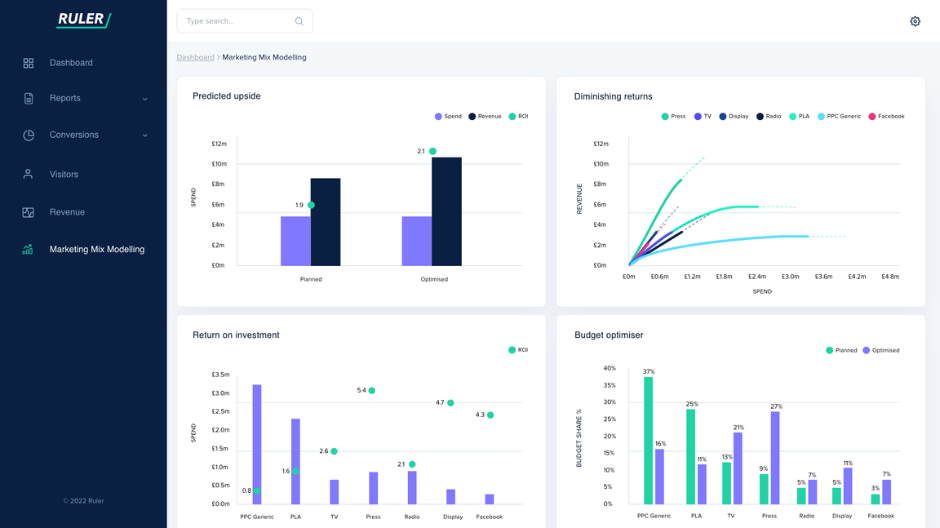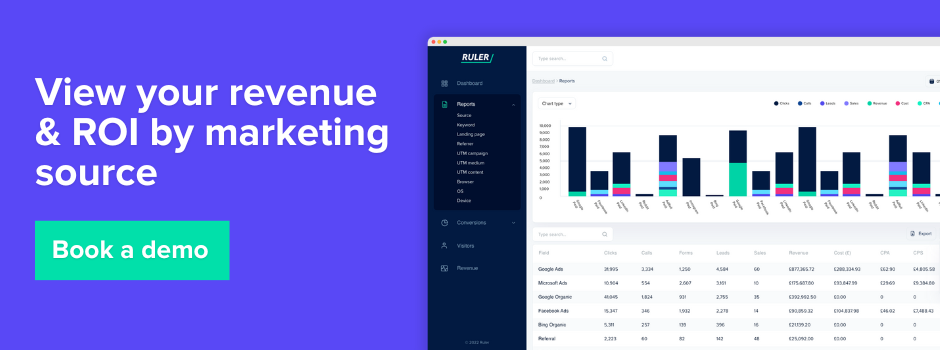Do you want to prove and increase your return on investment? We spoke to our customers to learn how Ruler has helped them boost their ROI.
Return on investment is a difficult metric for most marketers. But it’s one that is essential to understanding what’s working, what isn’t and most importantly gives you insight into where you’re getting the most bang for your buck.
Digital marketing is highly saturated, and getting cut-through is getting harder and harder. As marketers use more and more channels and promote more and more content, they’re creating more data to track and analyse.
But where does all that data go? Well, for the most part, it gets locked away in certain apps or lost in the cloud.
We spoke to businesses currently using Ruler to find out how it’s helped them track and improve their return on investment.
Here’s what we’ll cover:
If you didn’t already know, Ruler is a marketing attribution tool that supports marketers to track users through the full customer journey so that they can see which touchpoints are working to reach, engage and close leads.
How Ruler works can be split into 3 easy steps.
Ruler integrates with your website to track and collect key data from anonymous visitors, such as their referral source, GCLID, and keyword data. It continues to collect data on visitors each time they visit your website.
Let’s use an example to help explain.
Ella visits your website for the first time via an organic search. Ruler tracks her visit and records the data including which pages she engaged with and her source.
A few days later, Ella revisits your site via a direct search. Ruler uses first-party data to track Ella and link her visit to her previous session on your website. This session’s data is added to her customer journey.

No matter how many times Ella engages with your website, Ruler will track and store the information you need to decipher how she’s engaging with your content.
If you work in B2B marketing, then chances are you’re generating leads for your business.
In this case, you’re likely seeing conversions occur via form fills, phone call, live chat and more.
There are key difficulties with this. Tracking lead count is one thing, but linking a lead to a website session is another.
With Ruler, you can track both.
When a visitor converts into a lead, Ruler matches their conversion details with their previous marketing touchpoints, so you can see how each touchpoint contributed to the conversion.
Let’s return to our example.
Ella has visited your website twice now. On her third visit via an organic search, she filled in a form to convert into a lead.

At this point, without Ruler, you would see Ella in your CRM. The data you would have on her would include what she provided in the form.
With Ruler, you’ll be able to see the previous two sessions and how she engaged with your content.
Ok, so we can track touchpoints and leads, but how does Ruler link revenue to your marketing touchpoints?
Naturally leads will move through the sales pipeline over time. Ruler will continue to track their progress and feed data into its reports, allowing your marketing team to see how leads are moving through the pipeline and identify any areas where they may be getting stuck.
When a lead is eventually won, Ruler sends the revenue amount back to its system and allocates it to the touchpoints that influenced the deal.

Here you can use different attribution models to determine how much credit each touchpoint deserves and make more informed decisions about your marketing budget and allocation.
Tracking ROI is just the first step.
It’s essential to know how long your campaigns will generate positive ROI and whether you can boost revenue with other marketing channels or tactics at a lower cost.
To do this, you need to be able to forecast future returns and understand the diminishing returns of different marketing channels and tactics.
And Ruler can help you do just that.

Alongside attribution, Ruler offers marketing mix modelling.
MMM is a statistical analysis technique that helps marketers understand how different marketing channels and tactics affect revenue. It’s used to identify the most effective marketing channels and tactics and forecast future returns.
Ruler has three core features that help predict and improve ROI:
With Ruler’s ROI features, marketers can answer questions like:
Ok, so now we know exactly how Ruler works to better track your users, leads and customers so that you can link revenue to marketing.
But how does this help you improve your ROI?
We reached out to some of our current customers to see how it’s worked for them.
With a tool like Ruler Analytics in place, you can view simple reports which show exactly how much revenue marketing channels, campaigns, ads and keywords are driving.

Stephanie Henderson, Senior Account Manager at Distract said, “Since we started using Ruler as a tool for our advertising campaigns, we’ve seen Ruler track and attribute our conversions. Ruler is an essential tool that helps us prove ROI to our clients, and it makes day-to-day reporting and breaking down critical metrics so much easier.”
Stephanie continued: “Without Ruler, we would lose half of our tracked conversions, which could mean we make the wrong decisions and turn off campaigns that are actually driving high quality, converting traffic.
Unlike most attribution tools, Ruler lets you connect phone calls to marketing touchpoints. This is important as phone calls are still a major source of leads and sales for many businesses.
Ruler offline attribution works by overriding the phone number on your website and replacing it with a unique phone number for each visitor.
When a visitor dials the number, they are automatically forwarded to your regular phone number. This allows you to track which marketing source and touchpoints led to the conversion and get a more accurate picture of ROI.

Chris Hirlemann, Head of Data at Sleeping Giant Media, said, “We use ROI to help tie the online leads to offline sales. This allowed us to identify which channels drove the hottest leads and actually calculate ROI.”
Business Development Director at Morgan Pryce, Jimmy Tranhas, has experienced significant enhancements in offline attribution thanks to Ruler.
“We are picking up on average 2 to 3 dropped calls a month through Ruler. This is tracked on a keyword level. It’s next level intel that allows us to do better follows armed with more information,” says Jimmy.
Ruler has a lot to offer. We consistently support our customers to prove and improve their return on investment. With Ruler in place, you can cut costs and grow your business by pinpointing what works.
Data-driven marketing doesn’t need to be a pipedream anymore with a tool like Ruler in place. Book a demo to see the tool in action, or read more about what you can get access to in Ruler.
